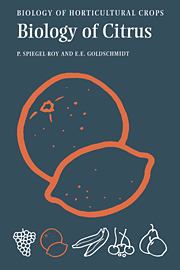4 - Reproductive physiology: flowering and fruiting
Published online by Cambridge University Press: 27 October 2009
Summary
The flowering of citrus
Introduction
The transition of the vegetative, leaf producing meristem into the reproductive floral meristem is the initial event in the long chain of developmental processes leading to seed and fruit production.
The environmental and endogenous control of flower bud differentiation is quite complex and varies considerably from one species to another. Citrus trees, like other fruit trees, are polycarpic plants undergoing repeated cycles of flowering and fruiting. Fruit trees never commit all their buds to flowering – a certain number of buds must be retained in the vegetative, non-differentiated state to ensure the tree's future. This raises certain questions with regard to the nature of floral induction in fruit trees. The suggestion has been made that flowering in fruit trees might be under ‘negative’ control, i.e. all buds are induced to flower but their actual flowering is controlled by the presence of a ‘flowering inhibitor’. This hypothesis must be weighed against the more common concept of a positive ‘floral stimulus’ which must reach the apex to start the process of flower bud differentiation (Lang, 1965).
Certain aspects of citrus' floral development derive from the nature of citrus as a tropical-subtropical evergreen which, unlike deciduous fruit trees, does not have true dormancy (Monselise, 1985). Deciduous fruit trees form flower buds during early summer. These flower buds complete their morphological development prior to the onset of winter dormancy and appear to be ready by the fall for the burst and bloom of the following spring.
- Type
- Chapter
- Information
- The Biology of Citrus , pp. 70 - 125Publisher: Cambridge University PressPrint publication year: 1996
- 2
- Cited by



